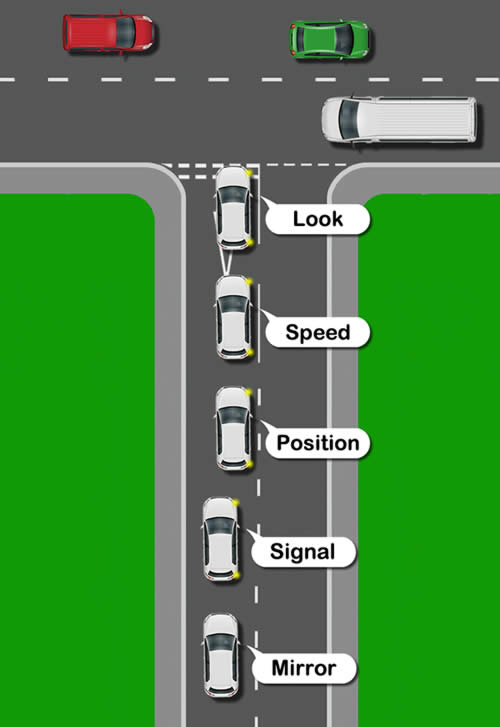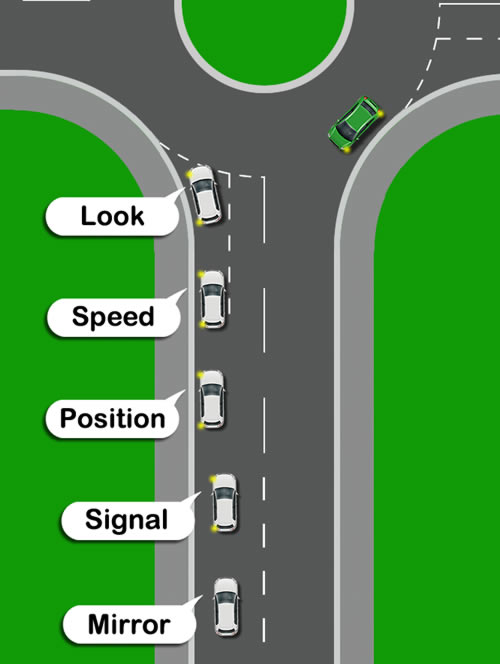As with all the learning to drive routines, the mirror, signal, position, speed, look (MSPSL) routine is a system that’s easy for learner drivers to remember. By following the MSPSL routine, you’ll be abiding by safe driving practices that will go on to help you pass the driving test and have a safe future on the road.
What Does MSPSL Stand for in Driving?
MSPSL is a driving routine that stands for Mirror, Signal, Position, Speed and Look. It’s essentially a modern, more thorough version of the traditional Mirror, Signal, Manoeuvre (MSM) routine.
Why Do I Need to Learn the MSPSL Routine?
As a learner driver and eventually, a fully qualified driver, safety is priority for both yourself, your passengers and other road users. As you begin learning to drive, you’ll be taught how to correctly use your mirrors, your indicators, correct road positions, appropriate speeds and where and when to look.
At an early stage, your driving instructor will teach you the MSPSL routine so that by the time you reach test standard, you’ll be putting the MSPSL routine into practice without thinking about it.
By putting the MSPSL routine to use, you’ll be making constant use of your new driving skills. Using the MSPSL routine is not only necessary for passing the driving test, but will provide you with a safer driving environment for life.
When Do I Use the MSPSL Routine?
You need to apply the MSPSL driving routine when approaching all types of road junctions, including:
- T-junctions
- Left and right turns
- Roundabouts
- Crossroads
You’ll also need to apply the MSPSL driving routine when approaching a hazard, which may include:
- Cyclists
- Horses
- Slow moving vehicles
- Vehicles emerging from junctions
- Passing parked cars
- School crossing patrols
- Sharp bends
- Pedestrian crossings
How do you do the MSPSL Routine?
Carry out the MSPSL driving routine using this specific order:
M = Mirror
When approaching any junction type, always start by checking your mirrors. You start by checking the interior mirror, followed by the left door mirror if you’re turning left, or the right door mirror if you’re turning right. Take notice of what you see in your mirrors, rather than simply just looking at them.
S = Signal
If turning left or right, changing lanes or pulling up at the side of the road, you must signal to other road users what your intentions are. Signal at the correct time; too early may cause confusion and too late may not give other road users enough time to react.
P = Position
You now need to find the appropriate road position based on the direction that you’re going. Some junctions have lanes, so it’s important to look ahead and position your vehicle into the appropriate lane in good time. Some junctions don’t have lanes, and unmarked junctions have no road markings at all.
These types of junctions are generally quiet, but it’s still important to correctly position your vehicle so that you do not hit kerbs or mount pavements. This is not only dangerous for pedestrians, but will also fail a driving test.
S = Speed
Speed is one of the most difficult skills to master. Every year, the top 10 most common reasons for failing a driving test is at junctions. One of these reasons is due to test candidates approaching junctions too fast. Each and every junction is different and requires a different approach speed based on what you can, or cannot see.
L = Look
You’ve completed your mirror checks to establish that it’s safe, you indicate in the direction you intend on traveling, you’ve moved to the correct road position and adjusted your car to a suitable speed and you now need to look.
Where you look depends on what you’re doing. If you’re making a left turn, look into the road before proceeding to ensure there are no pedestrians crossing or parked cars that you might need to wait behind. Before making a left turn, always take a final look in the left door mirror to ensure there are no cyclists coming up alongside you.
Lack of effective observations and junctions is the number 1 reasons for failing a driving each and every year. When attempting to move off at a T-junction, these reasons include failing to correctly judge the speed of approaching vehicles and failing to observe all road users, such as cyclists and pedestrians.
MSPSL Driving Routine Example
In this example of the MSPSL routine, we take a look at a driver turning right at a T-junction.

- Mirror: Interior mirror, followed by the right door mirror.
- Signal: Signal to the right.
- Position: Position the vehicle just to the left of the centre road line. If the road is wide enough, this will then allow another vehicle to stop on your left for making a left turn.
- Speed: Slow to an appropriate speed based on what you can or cannot see.
- Look: Assess the the speed of traffic. Look in both directions at least twice. Don’t forget to look vehicles that may be approaching particularly quick. Look also for cyclists and pedestrians.
In this next example, we’ll take a look at a driver turning left at a roundabout.

- Mirror: Interior mirror, followed by the left door mirror.
- Signal: Signal to the left.
- Position: On this roundabout, there are lanes, so position the vehicle into the left lane for making a left turn.
- Speed: You’ll need to give way to vehicles approaching from the right. Some roundabouts aren’t always too clear to see what’s approaching from the right as you approach. If your speed is too fast, you’ll likely end up having to stop. If you approach at an appropriate speed, you can often see that it’s clear and continue onto the roundabout without having to stop.
- Look: Try to look ahead and gauge what’s going on at the roundabout early on. Many learner drivers focus too much on the right when approaching roundabouts, resulting in bad road positioning. Quickly and continuously shift your observations between looking at what’s approaching from the right and the road ahead to monitor your road position.
The MSPSL routine is a lot to remember and initially quite complicated, but your driving instructor or supervising passenger will tell you what you need to do and in what order. Once you start remembering to do it on your own, they should prompt you only if you forget something or do something wrong.
How do I remember the MSPSL routine?
You’ll remember the MSPSL routine due to learning by rote. You’ll continuously repeat the same process over and over and you’ll eventually do it without having to think of the routine. Don’t worry if you forget things, your instructor or supervising passenger will be there to remind you.